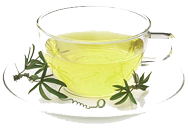.jpg)
.jpg) First of all, carefully loosened the soil, fertilized, leveled, and more. Planting himself - quite a complex operation. Tea bred seeds that are harvested in autumn when they fall out of the cups. Put them in groups, under the shade of mulberry trees and bamboo, as the tea is not like the big heat of the sun. Also seated between different scented plants such as roses, magnolias, olives, etc., for the tea plant - the plant is gentle and loves a good neighborhood. For the same reason you can not close it or to plant a vegetable garden plants love moisture, from this neighborhood tea plants may die.
First of all, carefully loosened the soil, fertilized, leveled, and more. Planting himself - quite a complex operation. Tea bred seeds that are harvested in autumn when they fall out of the cups. Put them in groups, under the shade of mulberry trees and bamboo, as the tea is not like the big heat of the sun. Also seated between different scented plants such as roses, magnolias, olives, etc., for the tea plant - the plant is gentle and loves a good neighborhood. For the same reason you can not close it or to plant a vegetable garden plants love moisture, from this neighborhood tea plants may die.
The tea bush is grown, with characteristic Chinese art, with limited height, with a tall shrubs are more rough leaves. In the fourth year after planting begin to collect leaves. In the first years of the fee is not so plentiful, but better quality. After seven, ten charges of 10-12 year, the tea bush is replaced with new spikes, that is, its "youth" as we have fruit trees.
Oschipko picking tea or tea plant is produced mostly three times a year, sometimes two. The first collection is made at the end of March (usually begin in the happiest day of March 23, Tsyn-Ming) or at the beginning of April, weather permitting. Previously, only the first shoots broken off and had just unfolded leaves, giving tea choice, the so-called first collection - the most expensive variety, though not in very large numbers. Then pluck ripe young leaves, which are in the provinces of Chiang-hsi, Hu Bei, Hu-nan and give other varieties that are very important in commercial terms.
The second collection is made in late May and June, when the list has evolved and become more mellow. It gives a more ordinary, common in trade, varieties - mainly Sino-liang (in Russian means "flower of the heart").
The third collection - in August of mature leaves, makes the toughest, cheap varieties. The best of them - the so-called red tea. Occasionally a third collection is not done, so as not to reduce the first gathering next year.
In other areas produce even a fourth collection - autumn, at the end of August or September. This collection gives a rough leaves - the lowest grade of tea. Part of it is consumed by the poorest population, some mixed with the other classes (for touch), mainly to the old stale tea.
Collection of the best varieties produced with great care and very carefully. Workers hands are washed thoroughly, every smell is eliminated (not even eat onions, which is a great deprivation for the Chinese). Sprouts nails plucked and thrown into clean water. Hardened branches and leaves are discarded obsolete, seleсting small sprouts, a little hard, as if covered with flock, which are called flowers (they are called floral tea). This work is very meticulous, experienced worker assembles a day not more than ten pounds of leaves.

.jpg) First of all, carefully loosened the soil, fertilized, leveled, and more. Planting himself - quite a complex operation. Tea bred seeds that are harvested in autumn when they fall out of the cups. Put them in groups, under the shade of mulberry trees and bamboo, as the tea is not like the big heat of the sun. Also seated between different scented plants such as roses, magnolias, olives, etc., for the tea plant - the plant is gentle and loves a good neighborhood. For the same reason you can not close it or to plant a vegetable garden plants love moisture, from this neighborhood tea plants may die.
First of all, carefully loosened the soil, fertilized, leveled, and more. Planting himself - quite a complex operation. Tea bred seeds that are harvested in autumn when they fall out of the cups. Put them in groups, under the shade of mulberry trees and bamboo, as the tea is not like the big heat of the sun. Also seated between different scented plants such as roses, magnolias, olives, etc., for the tea plant - the plant is gentle and loves a good neighborhood. For the same reason you can not close it or to plant a vegetable garden plants love moisture, from this neighborhood tea plants may die.